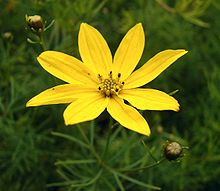Coreopsis verticillata is a North American species of tickseed in the sunflower family. It is found primarily in the east-central United States, from Maryland south to Georgia, with isolated populations as far west as Oklahoma and as far north as Québec and Ontario.[1] The common names are whorled tickseed,[2][3] whorled coreopsis, thread-leaved tickseed, thread leaf coreopsis, and pot-of-gold.
| Coreopsis verticillata | |
|---|---|

| |
| Scientific classification | |
| Kingdom: | Plantae |
| Clade: | Tracheophytes |
| Clade: | Angiosperms |
| Clade: | Eudicots |
| Clade: | Asterids |
| Order: | Asterales |
| Family: | Asteraceae |
| Genus: | Coreopsis |
| Species: | C. verticillata
|
| Binomial name | |
| Coreopsis verticillata | |
Description edit
Coreopsis verticillata is an herbaceous perennial that grows 2–3 ft (1–1 m) tall and about 2 ft (1 m) wide, although as it spreads laterally by rhizomes,[4] this width can be exceeded. The stems are wiry.[5] The flower heads are up to 2 in (51 mm) across, and both the disc florets and ray florets are bright yellow. The flowers are produced abundantly in clusters from midsummer to fall.[6]
Habitat edit
Coreopsis verticillata can commonly be found in dry, thin woods and open pinelands, preferring sites with full sun exposure. It can tolerate drought, poor soil, extreme heat, and neglect.[5]
Horticultural cultivation edit
Coreopsis verticillata and its horticultural cultivars are not difficult to grow and hence make good starter plants for beginning gardeners in the U.S.[7] They have a long flowering season and are relatively free from pests and diseases.[7] They attract butterflies and are deer resistant.[7] They can be grown in hanging baskets and containers (where irrigation will be necessary), or as border plants.[8] Carolyn Singer, in "Deer in My Garden", reports that C. verticillata is a good companion plant with other summer-blooming perennials requiring similar conditions.[9] The following notable cultivars have gained the Royal Horticultural Society's Award of Garden Merit:
- 'Grandiflora' - taller than other cultivars, with slightly larger flowers[10]
- 'Moonbeam' - pale, sulphur-yellow flowers, slightly shorter growth, chosen as the 1992 Perennial Plant of the Year by the Perennial Plant Association.[5] When this cultivar was first introduced to the market, demand outstripped supply in some localities, such was its popularity.[11][12]
- 'Zagreb' - shorter than the species, bright yellow flowers[13][14]
References edit
- ^ Biota of North America Program 2014 county distribution map
- ^ BSBI List 2007 (xls). Botanical Society of Britain and Ireland. Archived from the original (xls) on 2015-06-26. Retrieved 2014-10-17.
- ^ USDA, NRCS (n.d.). "Coreopsis verticillata". The PLANTS Database (plants.usda.gov). Greensboro, North Carolina: National Plant Data Team. Retrieved 17 January 2016.
- ^ "Coreopsis verticillata L." Wildflower Center at The University Of Texas At Austin. Retrieved 2010-02-20.
- ^ a b c Christman, Steve. "Coreopsis verticillata". Floridata. Retrieved 2010-02-20.
- ^ Flora of North America, Coreopsis verticillata Linnaeus, Sp. Pl. 2: 907. 1753.
- ^ a b c "Coreopsis verticillata 'Moonbeam'". Perennial Resource. Archived from the original on 2011-07-15. Retrieved 2010-02-20.
- ^ "Coreopsis verticillata". Magnolia Gardens Nursery. Archived from the original on 2009-05-28. Retrieved 2010-02-20.
- ^ Singer, Carolyn (2006). Deer in My Garden: Vol. 1: Perennials & Subshrubs. Emerald Book. ISBN 978-0-9774251-0-5.
- ^ "RHS Plant Selector Coreopsis verticillata 'Grandiflora' AGM / RHS Gardening". Apps.rhs.org.uk. Retrieved 2013-06-06.
- ^ Iannotti, Marie. "Coreopsis verticillata 'Moonbeam'". About.com. Archived from the original on 2013-01-17. Retrieved 2010-02-20.
- ^ "RHS Plant Selector Coreopsis verticillata 'Moonbeam' / RHS Gardening". Apps.rhs.org.uk. Retrieved 2013-06-06.
- ^ "Coreopsis verticillata Zagreb". North Creek Nurseries. Retrieved 2010-02-20.
- ^ "RHS Plant Selector Coreopsis verticillata 'Zagreb' AGM / RHS Gardening". Apps.rhs.org.uk. Retrieved 2013-06-06.
External links edit
- Media related to Coreopsis verticillata at Wikimedia Commons
- Data related to Coreopsis verticillata at Wikispecies